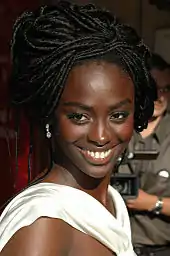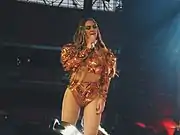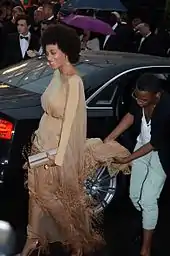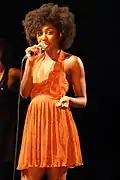Natural hair movement
The natural hair movement is a movement which encourages women and men of African descent to keep their natural afro-textured hair. It originated in the United States during the 1960s, with its most recent iteration occurring in the 2000s.[1][2]
Definition and features
The movement designates Black people who wear afro-textured hair in its natural, coiled, kinky or tight curly state. The word 'nappy' has been subjected to denigration since the Atlantic slave trade. Thereafter, some Afrodescendants have positively taken the word back. In francophone countries, it is often reanalyzed as a portmanteau of 'natural' and 'happy'.[3][4][5][6]
These individuals of African descent give up "relaxing their hair and allow it to grow in its natural texture. To relax your hair means to chemically straighten it, which can be done professionally or a kit can be purchased at a grocery store for home use.".[7] Their hairstyles can vary by the adoption of hair twists, braids or even dreadlocks.[3][8] Not everyone who wears their natural hair chooses to forgo all (non-chemical) forms of straightening or styling. Additionally, "being natural" does not necessarily indicate a strict adherence to any particular type of product or styling regimen; nor should it be tied exclusively with certain social or political beliefs. There are many reasons why African American women decide to "go natural" The main reason for the movement is for women to redefine what beauty is or means in the black community.[9]
History
The return to natural hair in the organic era,[10][11] has been encouraged by the awareness of the harmful effects of relaxers on the scalp: Itches, red patches, burns, broken hairs or worse: alopecia. However, among black women, 98% have had their hair straightened at least once in their lives, and relaxers have represented no less than 70% of the cosmetic purchases carried out by the population. In the 1980s–1990s, hair straightening was mainstreamed.[5]
During the 1970s–1980s, the ′Jheri curl′, another technique to loosen tightly curled hair, became fashionable in the African American community, popularized especially by some celebrities such as Michael Jackson, seen in the music video for his song Thriller.
During these same years, a new hairstyle appeared too: dreadlocks (naturally matted hair locks), popularized by Bob Marley and more generally by reggae music and the Rastafarian movement. This hairstyle can be a mark of social and spiritual distinctions: "The adoption of long or very atypical hair [can reflect] rebellion or a refusal of the dominant values."[6][12]
In the period between the 1960s–1970s, the racial segregation between the black and the white reigned in the United States. Angela Davis, a young human rights activist and member of the revolutionary movement Black Panthers created in 1966, made the Afro hairstyle famous. This dense and spherical hairdressing thus symbolized the emancipation and cultural affirmation of the African Americans. It was adopted by many stars like Diana Ross and the Jackson 5.[13][14][4][6][15]
A century earlier, in 1865, slavery was abolished at the end of the American Civil War. Nevertheless, black populations looked for straightening their hair, so as to move closer to the dominant aesthetics, if only to find employment. At the time, the most used instrument was the hot comb, until 1909, when Garrett A. Morgan invented a revolutionary relaxer cream.[14][4][12][16]
During the Atlantic slave trade, the conditions of servitude did not allow to take care of one's hair, which was subjected to denigration by the master: 'nappy' became a pejorative term.[17][18]
The deportation of millions of Africans made them separate from their originally aesthetic activities regarding hair care.[16]
In the ancestral traditions, hairdressing was "an activity during which the genealogies' history and many other cultural features were taught to children. Every African hairdressing was codified according to the ethnic group and by status."[14]
Hair is a very important aspect of African life. The thickness and healthiness of the hair mirrors positive attributes from the culture for both women and men. Normally it is the elders who style the all of the hair in one's family and it is important for the others to learn how to do so. The tradition of braiding and styling hair is so sacred that there are actually a lot of rules and guidelines for it including: when and where to style, differences based on gender, different rituals and customs.
It is the loss of this instrument [the African comb], all the more valuable that it is essential to the nappy hair care, which was going to dissociate Black people from the nature of their own hair, considered therefore as "difficult to comb". ... The African was snatched from his comb when he was snatched from his native land and thus taken away from an irreplaceable cultural symbol, legacy, and accessory from his beauty culture.
— Juliette Sméralda, Peau noire, cheveu crépu: l'histoire d'une aliénation
The independent documentary film My Nappy Roots: A Journey Through Black Hair-itage was released in 2005. The highly acclaimed film won multiple awards and played on the college circuit. With years of research, the film historically looked at the word "nappy." My Nappy Roots chronicled over 400 years (and 200 hours of footage) of Afro hair culture starting in Africa through the middle passage, reconstruction the creation of the Black hair industry to the year 2008. The documentary postulated the word 'nappy' derived from the word 'nap', which was the name of the small cotton balls inside of a cotton plant. The word 'nappy' was born because it resembled the texture of unkempt Afro-textured hair. In an effort to be more acceptable socially, it was more desirable to have straight hair like the dominant culture. The release of Chris Rock's 2009 comedy documentary Good Hair further popularized the concept of nappy hair and the use of chemical relaxants to audiences that were previously unaware of its meaning.
The natural hair movement today
For about ten years, thanks to Web 2.0, a growing number of people have been sharing their beauty advice via:
- Blogs: Black Girl Long Hair,[1][19][20] Naturally Curly,[1][19][21] Curly Nikki,[1][22][23] Hair Lista,[19][24] Afrobella,[1][25][26] Un-ruly.com[27][28][29] in the US; Black Beauty Bag,[6][30][31][32] Afrobelle,[33][34] Ivy-Mag[35][36] in France
- Web-zines: Naturally Happy Hair[37] in the US; FashizBlack,[3][38] Afrosomething[39][40][41] in France; Afro Style Magazine[42] in the Netherlands
These websites have expanded the natural hair movement around the world so as to highlight the beauty of natural hair.[3][13][16]
Each woman has her own reason to retrieve her authenticity; some of them want to preserve their hair against aggressive hair styling methods such as weaves being too tight or harmful straightening chemical products. Other women simply prefer their natural hair in spite of the pressure from the dominant aesthetics.[14][4][5][43]
The natural hair movement has been encouraged by some stars who have abandoned straightening, allowing their natural hair to make a comeback. Prominent examples of notable women in the natural hair movement are Erykah Badu, Lupita Nyong'o, Solange Knowles, Janelle Monáe, and Viola Davis.
In 2014 The Curly Girl Collective[44] held their first CurlFest, a now annual festival held in Brooklyn, NY that celebrates natural hair. Outside the US, several events have developed in order to accompany the natural hair movement, particularly in France and in Africa:
- The salon Boucles d'ébène: A demonstration, has existed for ten years, dedicated to the black hairdressing and beauty.[3][45][46][47]
- The Miss Nappy Paris′ competition: The election of "Miss Nappy" so as to promote the Afro hair beauty.[3][48]
- The Massalia Nappy Days: Lectures, projections of documentaries and fashion shows.[49]
- The Crépue d'ébène Festival at Abidjan (Ivory Coast): Dedicated to the natural beauty of the African woman and to the highlighting of the nappy hair.[50]
- The Natural Hair Academy: Event to better understand the nappy hair, days of advice by speakers.[3][51]
- The AfricaParis Festival: Dedicated to the "Afropean" culture.[3]
On July 3, 2019, California became the first US state to prohibit discrimination over natural hair. Governor Gavin Newsom signed the CROWN Act into law, banning employers and schools from discriminating against hairstyles such as afros, braids, twists, and dreadlocks.[52] Likewise, later in 2019 Assembly Bill 07797 became law in New York state; it "prohibits race discrimination based on natural hair or hairstyles."[53]
 Erykah Badu at a concert in July 2008.
Erykah Badu at a concert in July 2008.
 Aïssa Maïga during the 2007 Cannes Film Festival.
Aïssa Maïga during the 2007 Cannes Film Festival.
 Beyoncé sporting braids during the Formation world tour.
Beyoncé sporting braids during the Formation world tour.
 Inna Modja during a concert at Vaux-sur-Mer 9 August 2012.
Inna Modja during a concert at Vaux-sur-Mer 9 August 2012..jpg.webp) Janelle Monáe sang live at the Austin Music Hall on the occasion of SXSW in March 2009.
Janelle Monáe sang live at the Austin Music Hall on the occasion of SXSW in March 2009.
"Ethnic" hair care industry
With the popularity of "going natural", hair care suppliers have seen a rapid decrease in the purchase of relaxers, the harsh chemical hair straightener. An industry that was once worth an estimated $774 million, relaxer sales have gone down 26% over the last five years, 2013 numbers report.[54] Relaxer sales have fallen to 38% between 2012 and 2017. Sales are estimated to decrease to 45% by 2019.[54]
Women who wear their hair natural are now spending more money on products that will achieve the best result for their hair, and hair care suppliers and markets are taking note. Black consumers represent a lucrative market for hair care suppliers, so the brands now have to adjust for the new hair movement.[54] Brands have greatly lowered their production of relaxers and instead now produce more natural-friendly products. In choosing what products to consume, black consumers rely heavily on social media to gauge results from others who have gone natural. They have done this by the use of YouTube videos as tutorials on how to use products efficiently and create reviews for potential consumers to watch. Popular brands and products include Shea Moisture, DevaCurl, and Carol's Daughter.[55]
Controversy
Many women of African descent have faced opposition from wearing their hair in naturally curly styles or other non-straight, protective styles.
Many women have found that they are treated unjustly based on having naturally afro-textured hair. Natural hair can be deemed as "unprofessional", turning it into a fireable offense.[56] For example, a 12-year-old student at a Florida Christian school with natural hair "was given one week to decide whether to cut her hair or leave the academy that she has attended since third grade" after she complained to school officials about being bullied by other students.[57] In March 2014, the United States Department of Defense issued a set of guidelines that banned all afros, dreadlocks, braids, and twists that were greater than 1⁄4" in diameter. Guidelines such as these clearly disproportionately affect and target those of African descent.[58] They later rolled back the guidelines that same year in August by allowing two-strand twists. The Army increased the size of permissible braids and removed the word "unkempt" from their guidelines.[59] In April 2016, a female Zara employee in Toronto was reprimanded for wearing her hair in a braided hairstyle, which resulted in her filing a complaint with the Ontario Human Rights Commission.[60]
Hair appropriation/cultural appropriation has been an issue within the natural hair community. Many non-women of color especially celebrities, often wear African-American hair styles, which some have found offensive. Giuliana Rancic apologized to actress Zendaya Coleman—who wore dreadlocks on the 2015 Oscars red carpet— after commenting that Zendaya's hair must have smelled of "patchouli oil or weed".[61] It was pointed out that Rancic had praised dreadlocks as "edgy" when worn by Kylie Jenner, who is white.[62]
Kim Kardashian wore Fulani braids (originating from the Fulani tribe of West Africa) on three different occasions without acknowledging the origin of these braids.[63] She referred to them as 'Bo Derek' braids' after Bo Derek, an actress from the 1980s who wore Fulani braids in the 1979 film 10. Kardashian received backlash especially from the black community but did not acknowledge the response. The idea of non-black women wearing natural hair styles remains controversial.
Terminology
Several words are frequently used in the vocabulary of the natural hair movement:[13][8][64][65][66]
- Creamy crack
- Chemical relaxers. The term was coined with the thought that the use of relaxers is addictive for those women who strive for a permanently straight hair texture.
- Coily
- The texture characteristic of natural Type 4 hair, whereby the configuration of the strand resembles a small-diameter ink pen spring.[67]
- Coils
- A hairstyle achieved by taking small sections of wet or very damp hair and smoothing, while rotating the sections, one by one, from root to tip. Tiny styling combs or a finger are typically used.
- Big chop
- Cutting one's chemically straightened hair to let it grow in its natural texture.
- Bantu knot
- Hairstyle that consists of twisted hair rolled up into small buns. See Jada Pinkett Smith as Niobe in The Matrix series.
- Transition
- Period of time when one is transitioning from straightening their hair with heat/and or chemical products to wearing hair in its natural state.
- Protective hairstyle
- Hairstyle that protects natural hair from the elements. Includes braids, extensions, wigs, and weaves. See Janet Jackson in Poetic Justice (film).
- TWA (Teeny Weeny Afro)
- Short Afro haircut. See Viola Davis in the film Suicide Squad.
- Twists
- Double strands of hair wrapped around each other.
- Twist out
- Hairstyle where twists are unraveled. See Corinne Bailey Rae.
- Frohawk
- Hairdressing similar to the mohawk hairstyle.
- Shrinkage
- Because natural hair is typically has different types of curls and textures, in its natural state it appears shorter than it would straightened.
- Co-wash
- Washing one's hair with conditioner instead of shampoo.
- Wash and go
- wash one's hair and going on about one's day. This means there is no drying or styling involved and the application of product is minimal (usually a moisturizer or anti-frizz serum). The wash and go is also sometimes referred to as the "shake and go" which further emphasizes the lack of actual styling involved. The goal of a wash and go is to define natural curls.[68]
- Braids
- Hairstyle where hair is braided with extensions or with natural hair.
- Braid out
- Braids are unraveled.
- Dreadlocks
- Matted or sculpted ropes of hair.
- Senegalese twists
- Also known as rope twists where synthetic hair is used and twisted in with the natural hair.
- Afro
- A hairstyle created by combing the hair away from the scalp, allowing the hair to extend out from the head in a large, rounded:shape, much like a cloud or ball.
- Kinky hair
- Tightly curled hair, tightly coiled hair or hair without defined curls.
 Kinky hair is hair with tight curls, tight coils, or no defined curls.
Kinky hair is hair with tight curls, tight coils, or no defined curls. - Box braids
- A form of protective styling done through braiding synthetic hair along with real hair. This promotes hair growth and protects hair from breakage and other damaging factors.
- Cornrows
- A style of braiding/plaiting hair into narrow strips to form geometric patterns on the scalp. A form of protective styling.
- Protective style
- Any coiffure configuration that keeps hair ends safely tucked away. These hairdos require very little daily upkeep and help strands stay moisturized.[69]
Hair porosity
Natural hair can have low, high, or medium porosity. Low porosity hair cuticles are very tightly closed and don't absorb water or product easily. High porosity hair cuticles are very open and absorb water and product easily. Medium porosity is more balance and absorbs water, product, and moisture easily. In order to best treat naturally curly hair, celebrity hairstylist Andre Walker created a hair typing system. This categorizes hair into four categories based on how tight curls are coiled.
Filmography
- No Lye: An American Beauty Story, award-winning documentary written and directed by Bayer Mack in 2019.
- Nappily Ever After, movie directed by Haifaa Al-Mansour in 2018.[70]
- Good Hair, movie directed by Jeff Stilson and produced by Chris Rock in 2009.
- My Nappy Roots: A Journey Through Black Hair-itage, movie directed and produced by Regina Kimbell in 2008.
See also
References
- Dr. Josephine Metcalf and Dr. Carina Spaulding, African American Culture and Society After Rodney King: Provocations and Protests, Progression and "Post-Racialism", Ashgate Publishing Limited, 25/06/2015
- Bustle, The History Of Natural Black Hair, Plus How 2014's Afro Has A Whole New Meaning, 20/06/2014
- Le Monde, Crépues et fières de l’être, 05/02/2015
- RFI, Le mouvement Nappy : défrisage et cheveux crépus, released on 16/01/2013
- France Ô, La beauté noire, un marché porteur, released in 2014
- TV5 Monde, Dépigmentation de la peau et phénomène Nappy, January 2015
- "Permanent Hair Straightening & Chemical Relaxers | Philip Kingsley". www.philipkingsley.com. Retrieved 28 February 2019.
- L'Express, Parlez-vous le nappy?, 3 October 2012
- Wilkerson, Kamina (Spring 2019). "The Natural Hair Movement An Understated Revolution". Continuum Undergraduate Research Journal | Spring 2017: 57–63.
- Madame Figaro, Les cheveux ont faim, 11 November 2007
- INA, La phytothérapie, 7 November 2007
- Juliette Sméralda, Peau noire, cheveu crépu : l'histoire d'une aliénation, Jasor, 2004
- Le Point, Nappy, ce mouvement conquérant de la planète afro, 19 December 2014
- Jeune Afrique, Juliette Smeralda : « Le modèle de beauté qu'on vend aux femmes du continent n'est pas africain », 6 November 2014
- Marie Claire,Le nappy hair, nouvelle tendance des cheveux Afro30/04/2015
- Madame Figaro, Nappy hair : la revanche des femmes noires, 25/07/2014
- Maxine Leeds Craig, Ain't I a Beauty Queen?: Black Women, Beauty, and the Politics of Race, Oxford University Press, 2002
- Common Dreams NewsCenter, "Why 'Nappy' Is Offensive", 12/04/2007
- Dr. Johnson Elizabeth, Resistance and Empowerment in Black Women's Hair /Styling, Ashgate, 28/07/2013
- Huffington Post, Leila Noelliste's Life May Be Unconventional, But It's Awesome, 13/06/2014
- Business Wire, Ultra/Standard Acquires TextureMedia, 21/09/2015
- Huffington Post, CurlyNikki Responds To Ebony.com's Rejection Of White Women Joining #TeamNatural, 07/07/2014
- Ayana Byrd and Lori Tharps, Hair Story: Untangling the Roots of Black Hair in America, St. Martin's Press, 12/01/2002
- Lola Akingbola, 8 Weeks to Longer Hair!: A Guide for the Afro-Caribbean Woman. Discover Your Hair's Growth Potential!, Xlibris, 15/07/2013
- Jeffery A. Riley, 2011 Social Media Directory: The Ultimate Guide to Facebook, Twitter, and LinkedIn Resources, Que Publishing, 25/08/2010
- Derald Wing Sue, Miguel E. Gallardo and Helen A. Neville, Case Studies in Multicultural Counseling and Therapy, John Wiley & Sons, 12/08/2013
- "Meet the Founder of Un-ruly: A Place for Black Hair and Women – Man Repeller". Man Repeller. Retrieved 20 March 2016.
- "Hair doc digs deep into black roots". NY Daily News. Retrieved 20 March 2016.
- "9 Must-Follow Beauty Blogs for Girls With Natural Hair". Byrdie. Retrieved 20 March 2016.
- Le Parisien, Les nappys : afro, belles et contentes, 10/04/2014
- Amina, Fatou N’diaye, 26/04/2014
- RFI, Le mouvement Nappy : défrisage et cheveux crépus, 16/01/2013
- Alexa, Audience Afrobelle.com in France, retrieved 30/05/2015
- Maxi, Cheveux afro : les coiffer sans difficulté, 10/06/2015
- Salon Boucles d'Ébène, Bloguer en 2015 : Une passion ou un métier Archived 3 March 2016 at the Wayback Machine, 30/05/2015
- L'Express, Ivy Mag: « La beauté d’aujourd’hui est multiple et diversifiée », 15/02/2013
- Huffington Post, Open Letter to Allure, The New York Times and Other "Lamestream" Publications: If You Don't Know, You Better Ask Somebody, 08/07/2015
- Madame Figaro, Notre but : banaliser la mode afro et la beauté ethnique. , 26/01/2012
- Madame Figaro, Beautiful black blogs : huit filles à suivre sur le Net, 29/06/2015
- Le Point, En images : top 10 des meilleurs blogs féminins lifestyle, 05/09/2014
- Le Monde, A quand une femme noire en couverture de "Elle" ?, 31/01/2012
- MediaUpdate, AfroStyle Magazine issue 11 out now, 07/04/2015
- Jeune Afrique, Mode : La vague « Nappy » déferle en Afrique, 6 November 2014
- "Curly Girl Collective | Celebrating the Beauty of Natural Hair". www.curlygirlcollective.com. Retrieved 4 December 2018.
- Réseau Outre-Mer première, Aline Tacite, fondatrice du salon Boucles d'Ébène : "Nous chérissons nos cheveux crépus, frisés, bouclés et ondulés", 30/05/2015
- Juliette Sméralda, Du Cheveu défrisé au cheveu crépu, Broché, December 2012
- Le Monde, Salon Boucles d’ébène (30 May – 1st June), 27 May 2015
- FashizBlack, Océane Lebubura élue Miss NAPPY Paris 2015, 4 December 2014
- Mediapart, 1ères Massalia Nappy Days : Marseille sous le signe de la créativité et de la beauté au naturel, 17 September 2014
- FashizBlack, Abidjan accueille « Crépu d’Ebène », son 1er festival dédié aux cheveux naturels, 12 August 2014
- Elle Belgique, La Natural Hair Academy : le rendez-vous des nappy girls, 17 March 2014
- "California bans racial discrimination based on hair in schools and workplaces". JURIST. Retrieved 3 July 2019.
- "New York bans discrimination against natural hair". TheHill. 13 July 2019. Retrieved 18 July 2019.
- "Hair relaxer sales decline 26% over the past five years | Mintel.com". www.mintel.com. Retrieved 18 April 2016.
- "Products". The Natural Hair Movement. Retrieved 18 April 2016.
- Díaz, Alexa (27 June 2019). "California set to be first state to protect black people from natural hair discrimination". Los Angeles Times. Retrieved 28 June 2019.
- "Florida School Threatens to Expel African-American Girl for Wearing Natural Hair". Essence.com. 26 November 2013. Retrieved 19 April 2016.
- "Because Our Hair Is Always Political: 6 Black Women Fired For Their Hairstyles". Clutch Magazine. Retrieved 18 April 2016.
- Rhodan, Maya. "U.S. Military Rolls Back Restrictions on Black Hairstyles". TIME.com. Retrieved 19 April 2016.
- "Zara employee accuses store of discrimination over her hairstyle". www.cbc.ca. Retrieved 19 April 2016.
- "Giuliana Rancic Clarifies Apology to Zendaya After Oscar Night Comments About Her Dreadlocks". PEOPLE.com. Retrieved 18 April 2016.
- "Cultural Appropriation". The Natural Hair Movement. Retrieved 18 April 2016.
- Robin, Marci. "Kim Kardashian West Is Being Dragged for Wearing Fulani Braids to the MTV Awards". Allure. Retrieved 19 June 2020.
- Hellocoton, Le lexique Nappy Archived 24 September 2015 at the Wayback Machine, 21/0 April 2013
- Audrey Davis-Sivasothy, The Science of Black Hair: A Comprehensive Guide to Textured Hair, SAJA Publishing Company, 11 April 2014
- Leslie DuBois, Natural Beauty, Little Prince Publishing, 21 September 2014
- "As I Am Naturally". www.asiamnaturally.com. Retrieved 10 September 2018.
- "Curly Only While Wet? Type 4 Wash And Go Tips!".
- Cruel, Jessica. "29 Protective Styles That Will Save You Hours of Styling Time". POPSUGAR Beauty. Retrieved 4 December 2018.
- "Nappily Ever After (2018)". IMDb. Retrieved 19 November 2020.
Bibliography
- Aliona L. Gibson, Nappy: Growing Up Black and Female in America, Writers and Readers Ltd, 1 July 2000
- Juliette Sméralda, Peau noire, cheveu crépu : l'histoire d'une aliénation, Jasor, 2004
- Frantz Fanon, Peau noire, masques blancs, Seuil, 1952
- Willie Lee Morrow, 400 Years Without a Comb, Morrow's Unlimited Inc., 1973
- Ebony, Natural hair – new symbol of race pride, Johnson Publishing Company, December 1967
- Audrey Davis-Sivasothy, The Science of Black Hair: A Comprehensive Guide to Textured Hair, SAJA Publishing Company, 11/04/2014
External links
| Look up nappy, coil, curly, frizzy, kink, Afropean, or Afropeanity in Wiktionary, the free dictionary. |
| Wikimedia Commons has media related to Afro-textured hair. |
- Chinwe (12 January 2015). "The Natural Hair Movement in the '60s and '70s; How It Began and Why It Ended". Black Girl with Long Hair. Retrieved 31 March 2017.
